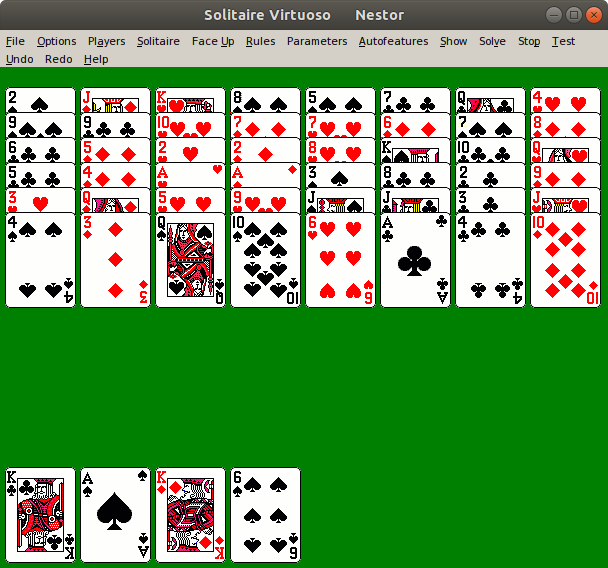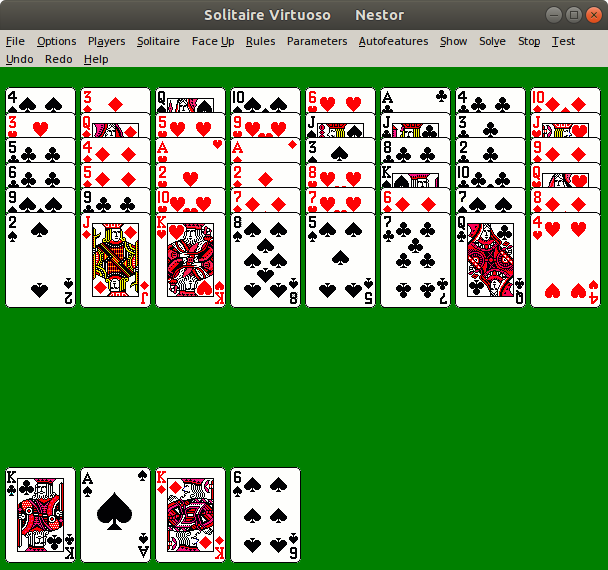Dual-Sided Nestor
This article describes a new variation of Nestor solitaire, and what strategy insights it provides for Nestor and its variants (Vertical, Doublets, etc.).
The inital layout of Dual-Sided Nestor is the same as regular Nestor, consisting of eight columns of six cards each, and four separate reserve cards that are available to be played at any time. As with Nestor, the columns may be dealt with "Rectification" so that no two cards of the same rank appear in any same column. Also similar to Nestor, two cards of the same rank may be discarded at a time, and the game is won if all 52 cards are removed. Cards at the bottoms of each column and in the reserve are available to be discarded. Unlike Nestor, the cards at the top of each column are also available for discarding with each other, or with cards in the reserve. However, a card from the top of one column may not be discarded with a card at the bottom of another column. If a column has been reduced down to one card, that card is both the top and bottom of that column, and therefore can be discarded with either the top or bottom card of any of the other columns.
How does the win rate of Dual-Sided Nestor compare with regular Nestor? It must be at least as winnable, since any Nestor solution would also be a valid Dual-Sided Nestor solution. However, any Dual-Sided Nestor solution can also be converted into a valid Nestor solution! To do so, play all the discards from the column bottoms first (in the same order), and then all the discards from the column tops, but in the reverse order. This means that Dual-Sided Nestor, despite the extra moves available, has a win rate that is identical to regular Nestor (approximately 59.7%, according to my Nestor solver).
Just as a game of Dual-Sided Nestor could be played like Nestor, by avoiding discards from the column tops, it could also be played in the reverse way: avoiding discards from the column bottoms, and therefore discarding top-down instead of bottom-up throughout the entire game. Because the discards in such solutions can be made in reveresed order as described above, this means that the columns in regular Nestor can be inverted such that the order of the cards is reversed, and the resulting Nestor game wauld be equally winnable as the original deal (win or loss), any solutions would just be in the reversed order of discarding. This was confirmed by solving one million Nestor deals using my Nestor solver, and for each deal, it also solved the same deal with inverted columns, and verified that both results were the same.
Given all of the above, a winnable Nestor deal can be thought of as being similar to a maze, in that the solution can be done from the entrance to the exit, or from the exit to the entrance, or both simultaneously until the two paths hopefully meet somewhere in the middle. Also like a maze, one can make a mistake from a winnable position, and explore a path that leads to nowhere but dead ends. But unlike a traditional maze, the fatal choices are different when traversing a Nestor game forwards or backwards. So, while a Nestor deal, the same deal of Dual-Sided Nestor, and the same Nestor deal but with inverted columns may all have essentially tbe same solutions (assuming a winnable game), they are not quite the same maze or puzzle (due to the different set of fatal choices).
Example of how the above insights can help when playing Nestor:
Virtuoso deal 69730 (see first screenshot below), at first glance, may appear to be reasonably promising. Looking at the bottoms of the columns, there are several pairs to choose from, discards that will lead to more possibilities. However, the tops of the columns are a much different story. If the columns are inverted (see second screenshot below), then only one pair (Kings) can be discarded before the game ends in a loss. By noticing that deal 69730 is like a maze with a blocked exit, you can conclude it is a loss without playing a single discard!


Any comments are welcome, please send to Mark Masten at:

Last modified August 31, 2021
Back to Nestor
Back to main page